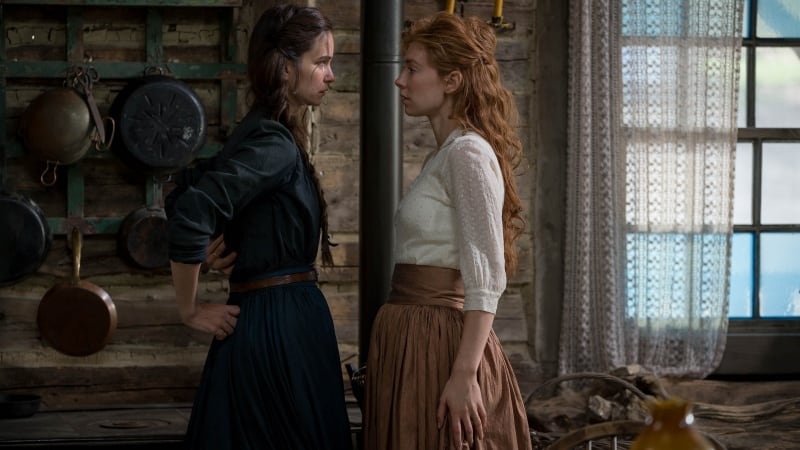Mona Fastvold’s The World To Come is another addition to the sad lesbian period piece canon that has become an audience favorite over the last decade. Adapting from Jim Shepard’s short story of the same name, Fastvold places this romance in frontier America, an isolated and claustrophobic setting that breeds hardened women and immense tragedy. Here, a secret relationship is born between two farmer’s wives looking for solace in their bleak world. However, despite the gorgeous cinematography and attempts to place their love in a new context, The World To Come perpetuates the stereotypically depressing representation of sapphic love.
Abigail (Katherine Waterston) lives on a secluded farm with her husband, Dyer (Casey Affleck). She is soft-spoken and thoughtful, observing the world around her and keeping her feelings close to her chest. Between the death of her daughter and the neverending duties of a farm, she is guarded and rarely smiles. But the viewer is granted special access to her deeper feelings as she narrates the film by reading the pages of her journal. In these pages, she is better able to open up about her grief, her deep loneliness, and what she perceives as her weakness as a spouse. She longs for a different life where she can travel the world, but she is resigned to her fate as a housewife. Then, everything changes when the new couple, Tally (Vanessa Kirby) and Finney (Christopher Abbott), arrive at a nearby farm.
Tally, with her flowing red hair, is the polar opposite of Abigail: she is outspoken, terrible at her “wifely” duties, and openly talks back to her husband in an attempt to hold on to her autonomy. The two women strike up a quick friendship where they can finally experience moments of joy, finally able to speak openly about their lives. Abigail smiles more, and her written words become even more poetic as she is swept up in a relationship that finally makes her heart sing. Their intimacy builds from long, quiet glances and bursts with an electric kiss that the viewer has been long waiting for.
Their husbands begin to notice their almost too-close friendship. Finney keeps records of where Tally goes and for how long, and Dyer remarks that Abigail only smiles when Tally is around. But despite the patriarchal system of control they live under, these women reject the status quo to follow their hearts. They secretly spit in the face of societal norms. Unfortunately, it ultimately comes crashing down around them as their love is squashed by a man’s jealousy.
The chemistry between Waterstone and Kirby is entrancing. Their gazes at one another speak volumes and make the viewer’s heart quicken as they can feel something extraordinary building between these women. Waterstone’s reserved Abigail versus Kirby’s self-assured Tally creates a beautiful balance; they complement one another and create a level playing field in their relationship dynamic. The World to Come’s brief moments of joy, such as when they lay on a blanket in the forest and read poetry to one another, are beautiful moments of love, making even the smallest kisses feel meaningful.
In contrast to their blossoming love is Andre Chemetoff’s grainy cinematography and muted color palette, which despite its dull colors, captures the beauty of 19th-century America. These shots balance dull grays and vibrant greens, resulting in a tension between an oppressive atmosphere and bursts of liveliness. Wide shots of natural landscapes each look like pastoral paintings, creating a giant and almost overwhelming look at frontier life in 19th-century America. This hazy beauty reflects the fantasy of the love between Tally and Abigail, one where they believe they can escape their husbands and be happy together.
However, the film’s tragedy detracts from its beauty, as their love is ultimately torn apart and Abigail’s emotional devastation comes full circle. This is another story about women in love in the past who continue to face tragedy. It’s been seen in Ammonite, Vita & Virginia, and Tell It To The Bees, just to name a recent few. Films that tackle such specific material can be done beautifully (see Celine Sciamma’s Portrait of a Lady on Fire) yet they continue to perpetuate this strange idea that two women in love are doomed to unhappiness. There’s no doubt that these stories provide ample opportunity for longing gazes, wide shots of the natural landscape, gorgeous costumes, and discussions about what it means to be a woman in a different time. Yet in creating the same stories over and over again, there becomes a concerning fascination with lesbians of the past who were never able to achieve true happiness.
Every technical aspect of The World To Come is breathtaking. They all come together to create a hazy and harsh world where two women can finally find solace in each other through clandestine embraces and share poetry. This is a film that showcases what queer period pieces could look like outside of tragedies, and creates an exceptional amount of sexual tension for a movie so quiet. Unfortunately, the film’s ending holds The World To Come back from standing out as a unique queer period piece. Tragedies aside, this is a film that will sweep you away to a beautiful yet harsh time where happiness came and left as quickly as a summer rain.

